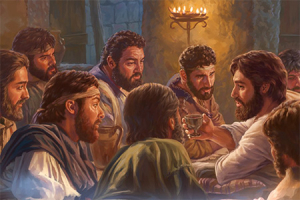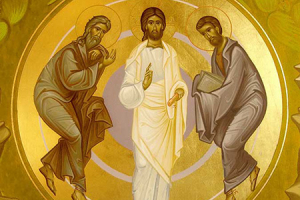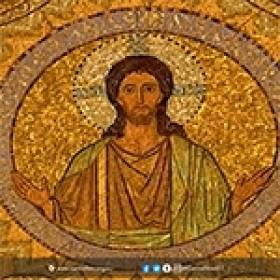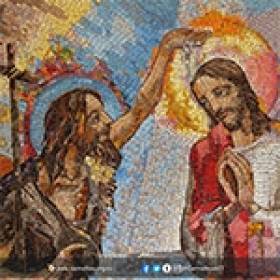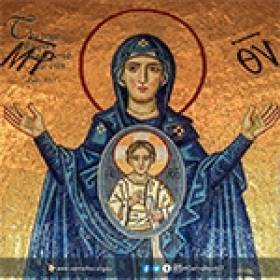Lectio Divina for April 2023
You can download and save the scripture texts, reflections and prayers for Lectio Divina for each day of this month. Lectio Divina is a traditional way of praying the Scriptures. Visit our Lectio Divina page for more information about how to pray using Lectio Divina. Join our Lectio Online group. We meet every Friday at 10am (Australian Eastern Daylight Time) [You are welcome to join from other time zones, eg. Perth/Singapore/Philippines: 7am; Timor-Leste/Tokyo: 8am; New Zealand: 12pm; Los Angeles: Thursday 4pm; New York/Toronto: Thursday 7pm] to prayerfully reflect on the Gospel of the coming Sunday.
Let him go free
The final of the three Great Gospels of Lent is ours today - a Gospel story of life and freedom. Like the gospels of the last two Sundays, the dramatic story of Jesus raising his friend Lazarus from the dead is a story of love, faith and belief.
There are three different groups of believers in the story: those who believe that Jesus could have prevented Lazarus’ death (Jesus is already known to be a healer); those who came to believe in him because they see Lazarus rise, and those, like Martha, who believe in Jesus even though Lazarus died.
In this Gospel Jesus proclaims himself ‘the resurrection and the life’. We see him deeply moved by the death of his friend. We find him in earnest prayer with God. We see him full of strength as he commands Lazarus to come out of the tomb.
pdf
Celebrating At Home 5th Sunday in Lent [PDF]
(5.57 MB)
default
Celebrating At Home 5th Sunday in Lent [ePub]
(4.25 MB)
Journey into the light
In this Sunday’s Gospel we accompany the man who was born blind on his journey into the light. The first thing we read in the full version of this Gospel is that Jesus announces that the man is sinless – he has been born blind so that God’s glory can be seen at work in him. Then Jesus gives the blind man sight. Notice that the man didn’t ask to be healed – this is Jesus’ initiative, taking the first step and reaching out in love. That’s how Jesus approaches us, too.
pdf
Celebrating At Home 4th Sunday in Lent [PDF]
(1017 KB)
default
Celebrating At Home 4th Sunday in Lent [ePub]
(3.56 MB)
Come and drink
The Gospels of the next three Sunday make clear that the Way from temptation to transfiguration is in and through Jesus Christ who is Living Water, Light and Life for the would-be disciple. They are three great stories from John about responding in faith...
pdf
Celebrating At Home 3rd Sunday in Lent [PDF]
(5.48 MB)
default
Celebrating At Home 3rd Sunday in Lent [ePub]
(5.41 MB)
Timor-Leste celebrates Fr Bruce
On Sunday 4 November the Carmelite Family gathered at St Elias Community in Hera for a Mass of Thanksgiving for Fr Bruce Clark. Fr Bruce is returning to Australia to take up his role as newly elected Prior Provincial after living in Timor-Leste for the last 10 years. During that time, he has served as Novice Master, Prior, Director of Formation and the Provincial’s representative in Timor-Leste. A large crowd of Friars, sisters and members of the Carmelite Family gathered to mark the occasion and express their gratitude for Fr Bruce’s presence and ministry in Timor-Leste.
"Thank You Fr. Bruce Clark, may the Lord Bless you always in your task as a Prior Provincial. We Pray always for you!" - Carmelite Community in Timor-Leste
Remembering & making present
This Gospel begs us ask ourselves if we are truly people who remember Jesus and allow his Spirit to shape our words, thoughts and actions so that he may remain present to us and to those around us.
pdf
Celebrating At Home Sixth Sunday of Easter [PDF]
(3.05 MB)
default
Celebrating At Home Sixth Sunday of Easter [ePub]
(3.01 MB)
Transfiguration
This Sunday’s Gospel of the Transfiguration completes the ‘little parable’ formed by the Gospels of the first two Sundays of Lent. These Gospels tell us what Lent is about and what Christian life is about: a journey from temptation and doubt to transfiguration and faith. A journey away from allowing ourselves to be tempted to evil, and towards allowing ourselves to be tempted to good by the action of God’s Holy Spirit within us.
pdf
Celebrating At Home 2nd Sunday in Lent [PDF]
(3.26 MB)
default
Celebrating At Home 2nd Sunday in Lent [ePub]
(5.05 MB)
Third Sunday in Advent (A) 2019
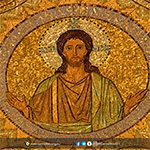 This Sunday marks the turning point in the Advent Season.
This Sunday marks the turning point in the Advent Season.
Traditionally called “Gaudete Sunday” it is a day of rejoicing that the Saviour is near. The focus shifts from the final coming of Christ at the end of time to the first coming of Christ at Bethlehem. The note of joy is symbolised by the inclusion of the colour rose among the purple of the Season.
Second Sunday in Advent (A) 2019
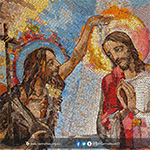 John the Baptist sits at the centre of this week’s Gospel and next week’s. He is the ‘one who cries in the wilderness: Prepare a way for the Lord; make his paths straight’.
John the Baptist sits at the centre of this week’s Gospel and next week’s. He is the ‘one who cries in the wilderness: Prepare a way for the Lord; make his paths straight’.
John was preparing the people for the coming of Jesus. Moved by his preaching many sought baptism in the river Jordan. This ancient water-rite symbolised dying to the old way of life and rising to a new way of life. That’s what repentance is about: turning away from sin and turning towards God. It is about true conversion of heart. It’s about making straight the pathways of our hearts. The fruit of our repentance and true conversion shows itself in good works.
First Sunday in Advent (A) 2019
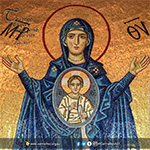 The great Advent journey begins. Once again we are struck by God’s astounding graciousness in sharing his life with us in the person of Jesus. “The Advent readings form a rich tapestry of images centered on the truth that God has come among us. In Advent we do not pretend that we are waiting for Jesus to be born in a stable. That happened once in history and it will not happen again. We remember that birth as we remember our own birthdays. The God who came among us is still among us. Advent’s invitation is to become aware of the all-pervading presence of the risen Jesus as Emmanuel – God among us.”
The great Advent journey begins. Once again we are struck by God’s astounding graciousness in sharing his life with us in the person of Jesus. “The Advent readings form a rich tapestry of images centered on the truth that God has come among us. In Advent we do not pretend that we are waiting for Jesus to be born in a stable. That happened once in history and it will not happen again. We remember that birth as we remember our own birthdays. The God who came among us is still among us. Advent’s invitation is to become aware of the all-pervading presence of the risen Jesus as Emmanuel – God among us.”
Carmelite Calendar
Download the Carmelite Liturgical Guide for this year -
pdf
2024 Carmelite Liturgical Guide
(714 KB)
[PDF]
JANUARY
3 St Kuriakos Elias Chavara (CMI), Priest, Optional Memorial in India
8 St Peter Thomas, Bishop, Feast
9 St Andrew Corsini, Bishop, Feast
20 Bl. Angelo Paoli, Priest, Optional Memorial, Memorial in Italy
29 Bl. Archangela Girlani, Virgin, Optional Memorial in Italy
FEBRUARY
1 Bl. Candelaria of St Joseph, Virgin, Optional Memorial in Latin America
MARCH
19 St Joseph, Spouse of the Virgin Mary, Principal protector of the Order, Solemnity
APRIL
17 Bl. Baptist Spagnoli, Priest, Memorial
MAY
4 Bl. Agel Prat Hostench & Companions, Martyrs, Optional Memorial
5 St Angelus, Priest and Martyr, Memorial
8 Bl. Aloysius Rabatà, Priest, Optional Memorial
9 St George Preca, Priest, Optional Memorial
16 St Simon Stock, Religious, Optional Memorial
22 St Joachina de Vedruna de Mas, Religious, Optional Memorial
25 St Mary Magdalene de' Pazzi, Virgin, Feast
JUNE
12 Bl. Hilary Januszewski, Priest and Martyr, Optional Memorial
14 St Elisha, Prophet, Memorial
JULY
4 Bl. Maria Crocifissa Curcio, Virgin, Optional Memorial in Italy
9 Bl. Jane Scopelli, Virgin, Optional Memorial
13 St Teresa of Jesus 'de Los Andes' (OCD), Virgin, Optional Memorial in Latin America
16 Blessed Virgin Mary of Mount Carmel, Solemnity
17 Bl. Teresa of St Augustine and Companions (OCD), Virgins and Martyrs, Optional Memorial
20 St Elijah, Prophet, Solemnity
24 Bl. John Soreth, Priest, Memorial
26 St Joachim and St Anne, Parents of the Virgin Mary, Protectors of the Order, Memorial
27 St Titus Brandsma, Priest and Martyr, Memorial
AUGUST
7 St Albert of Trapani, Priest, Feast
9 St Teresa Benedicta of the Cross (OCD), Virgin and Martyr, Memorial (Feast in Europe)
12 Bl. Isidore Bakanja, Martyr, Optional Memorial
17 Bl. Angelus Augustine Mazzinghi, Priest, Optional Memorial
25 Bl. Mary Baouardy of Jesus Crucified (OCD), Virgin, Optional Memorial
26 Bl. Jacques Retouret, Priest and Martyr, Optional Memorial
SEPTEMBER
1 St Teresa Margaret Redi (OCD), Virgin, Optional Memorial
17 St Albert of Jerusalem, Bishop and Lawgiver of Carmel, Feast
OCTOBER
1 St Thérèse of the Child Jesus (OCD), Virgin and Doctor of the Church, Feast
15 St Teresa of Jesus, Virgin and Doctor of the Church, Feast
NOVEMBER
5 Bl. Frances d'Amboise, Religious, Optional Memorial
6 St Nuno Alveres Pereira, religious, Memorial
8 St Elizabeth of the Trinity (OCD), Virgin, Optional Memorial
13 Bl. Maria Teresa Scrilli, Virgin, Optional Memorial in Italy
14 All Carmelite Saints, Feast
15 Commemoration of all Carmelite Souls
19 St Raphael of St Joseph Kalinowski (OCD), Priest, Optional Memorial in Poland
29 Bl. Denis of the Nativity (OCD), Priest and Martyr, and
Bl. Redemptus of the Cross (OCD), Religious and Martyr, Optional Memorial
DECEMBER
5 Bl. Bartholomew Fanti, Priest, Optional Memorial
14 St John of the Cross, Priest and Doctor of the Church, Feast
As approved by the Dicastery for Divine Worship and the Discipline of the Sacraments
18 November 2021
Change of Titus Brandsma (27 July) from Optional to Obligatory Memorial approved by the Dicastery for Divine Worship and the Discipline of the Sacraments
25 May 2023
History of the Carmelite Order
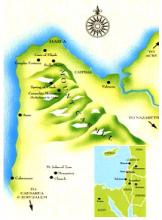 Origins & growth
Origins & growth
The Order of Carmelites has its origins on Mount Carmel, in Palestine, where, as we read in the first Book of Kings, the great prophet Elijah defended the true faith in the God of Israel, when he won the challenge against the priests of Baal. It was also on Mount Carmel that the same prophet, praying in solitude, saw the small cloud which brought life-giving rain after the long drought. From time immemorial, this mountain has been considered the lush garden of Palestine and symbol of fertility and beauty. Indeed, "Karmel" means "garden".
In the 12th century (perhaps after the third crusade, 1189-1191), some pilgrims who had come from Europe, came together near the "spring of Elijah", in one of the narrow valleys of Mount Carmel, to live out their Christianity as hermits after the example of the prophet Elijah in the very land of our Lord Jesus Christ. Then and in later times, the Carmelites did not acknowledge anyone in particular as their founder, but remained faithful followers of Elijah who was associated with Mount Carmel through biblical events and through Greek and Latin patristic tradition which saw in the prophet one of the founders of the monastic life. In the middle of the cells they built a chapel which they dedicated to Mary, Mother of Jesus, thus developing a sense of belonging to Our Lady as Patroness, and they became known by her name as "Brothers of Saint Mary of Mount Carmel". Thus Carmel is deeply associated with Elijah and Mary. From Elijah the Carmelites inherited a burning passion for the living and true God and the desire to make His Word intimately their own in order to witness to Its presence in the world; with Mary, the Mother of God, they are committed to live "in the footsteps of Jesus Christ" with the same intimate and deep feelings which were Mary's.
In order to have some juridical stability, this group of lay hermits turned to the Patriarch of Jerusalem, Albert Avogadro (1150-1214), who was then living at St John of Acre near Mount Carmel. Between 1206-1214, Albert wrote for them a formula of life. Successive approvals of this formula of life by various Popes helped the process of transforming the group into a Religious Order, a fact which took place at the time of the definitive approval of the text as a Rule by Innocent IV in 1247. Thus the Carmelite Order took its place alongside the Mendicant Orders.
However, about 1235, the Carmelites were forced to abandon their place of origin due to the incursions and persecutions of the Saracens who were reconquering the Holy Land from the crusaders. Most of them went back to their country of origin in Europe.
Soon they increased and flourished in the sciences and in holiness. Later some women attached themselves to the monasteries of the friars and in 1452 became cloistered nuns living in their own communities.
Reform & development
In the 15-16th centuries there was some relaxation of discipline in various communities, a fact greatly opposed by Priors General such as Blessed John Soreth (+1471), Nicholas Audet (+1562) and John Baptist Rossi (+1578), and by some reforms (among others those of Mantua and Monte Oliveti in Italy and of Albi in France) to put a stop to the spread of the abuses and the mitigations. The most famous reform is certainly the one started in Spain by St Teresa of Jesus for the reform of the nuns and then, helped by St John of the Cross and Fr Girolamo Gracian, for the reform of the friars. The most relevant aspect of this reform of Teresa is not so much that she opposed the mitigations introduced in the life of Carmel, but rather her ability to integrate in her project, vital and ecclesial elements of her time. In 1592 this reform, called that of the "Discalced Carmelites" or of the "Teresians", became independent from the Carmelite Order and grew rapidly in the congregations of Spain and Italy which were then united in 1875. Thus there are two Orders of Carmelites: "The Carmelites", also known as of the "Ancient Observance" or "Calced", and "The Discalced Carmelites" or "Teresians" who consider St Teresa of Jesus their reformer and foundress.
In spite of this division, during the following centuries the Carmelite Order continued its spiritual journey. Many illustrious men and women gave new spirit to Carmel with their own spirituality and genius. There was also significant development among the laity with the institution of the Carmelite Third Order and the Confraternities of the Scapular of Our Lady of Mt Carmel throughout the world. With the Reforms of Touraine in France, and of Monte Santo, Santa Maria della Vita, Piedmont, and Santa Maria della Scala in Italy, in the XVII and XVIII centuries the movement for a stricter observance spread everywhere.
At the dawn of the French Revolution, the Carmelite Order was established throughout the world with 54 Provinces and 13,000 religious. But as a result of the French Revolution the Order suffered great losses, such that at the end of the 19th century it was reduced to 8 Provinces and 727 religious. But it was this small band of religious who during the 20th century, with determination and courage, re-established the Order in places where it had been and also planted the Order on new continents.
The Carmelite Order today
Since the time of the Second Vatican Council (1962 - 1965), Carmelites have reflected at length on their identity, on their charism, on what is fundamental in their lives and what is for them a "life-project", namely "to live a life of allegiance to Jesus Christ and serve him faithfully with a pure heart and a good conscience" (Rule). They found their allegiance to Christ in their commitment to seek the face of the living God (contemplative dimension), in living in fraternity and service (diakonia) in the midst of the people. They see all this in the lives of the prophet Elijah and the Blessed Virgin Mary who were led by the Spirit of God. Looking at Mary and Elijah, it is easy for the Carmelites to understand, to interiorise, to live and to announce the truth that makes a person free.
Carmelites, conscious of being part of the Church and of history, live in a fraternity that is open to God and to people, able to listen and give an authentic response to the evangelical life according to their own charism, and they commit themselves to build the Kingdom of God wherever they are. Indeed they are committed to evangelisation in houses of prayer, centres for spiritual exercises, parishes, Marian sanctuaries, schools, religious associations; and to Justice and Peace wherever human dignity is trodden underfoot, especially among the poor, the marginalised, the suffering.
 To this vast and varied challenge of the Carmelite friars, one will find in close collaboration: communities of cloistered nuns, Congregations of sisters, Consecrated Lay people, numerous groups of Third Order Lay members and Confraternities of the Scapular of Our Lady of Mt. Carmel. All these groups, born of the Spirit throughout the centuries, and inspired by the Carmelite Rule are intimately united by the bond of love, of spirituality and of the communion of spiritual goods. They constitute the Carmelite Family in the Church. At present the Carmelite Order (the friars) is formed of Provinces, General Commissariats, General Delegations, Hermetical Communities and an Affiliated Community with a total of about 2,000 religious. They are found in all the continents.
To this vast and varied challenge of the Carmelite friars, one will find in close collaboration: communities of cloistered nuns, Congregations of sisters, Consecrated Lay people, numerous groups of Third Order Lay members and Confraternities of the Scapular of Our Lady of Mt. Carmel. All these groups, born of the Spirit throughout the centuries, and inspired by the Carmelite Rule are intimately united by the bond of love, of spirituality and of the communion of spiritual goods. They constitute the Carmelite Family in the Church. At present the Carmelite Order (the friars) is formed of Provinces, General Commissariats, General Delegations, Hermetical Communities and an Affiliated Community with a total of about 2,000 religious. They are found in all the continents.
Carmelite Rule
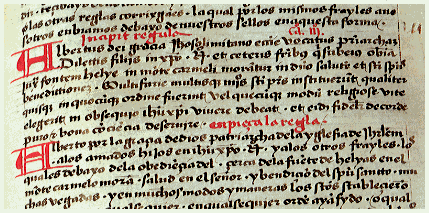 A rule of life was given to the early Carmelites by St Albert Avogadro, Patriach of Jerusalem between the years 1206 - 1214. It was finally approved by Pope Innocent in 1247 and later underwent mitigations which were not in the original text.
A rule of life was given to the early Carmelites by St Albert Avogadro, Patriach of Jerusalem between the years 1206 - 1214. It was finally approved by Pope Innocent in 1247 and later underwent mitigations which were not in the original text.
The Carmelite Rule states that is basic for a Carmelite to "live a life of allegiance to Jesus Christ - how, pure in heart and stout in conscience, he must be unswerving in the service of his Master" [no.2].
The Rule outlines the way to live out the Carmelite life in allegiance to Christ, according to the spirit of the Order. We are to ponder the law of the Lord, by day and by night, in silence and in solitude, so that the word of God may dwell abundantly in the hearts and on the lips of those who profess it. We are to pray with perseverance, especially by keeping vigil and praying the psalms. We are also to be clothed in spiritual armour; to live in fraternal communion, expressed through the daily celebration of the Eucharist, through fraternal meetings in chapters, through shared ownership of all material goods, through fraternal and loving correction of failings, and through a life of austerity, with work and penance, rooted in faith, hope and love, always conforming one’s own will to God’s, sought in faith through dialogue and through the prior’s service to his brothers. (Carmelite Constitutions n.11)
To live a life of allegiance to Jesus Christ, the Carmelites bind themselves especially to:
- develop the contemplative dimension of their life, in an open dialogue with God
- live as brothers, full of charity
- meditate day and night on the Word of the Lord
- pray together or alone several times a day
- celebrate the Eucharist every day
- do manual work, as Paul the Apostle did
- purify themselves of every trace of evil
- live in poverty, placing in common what little they may have
- love the Church and all people
- conform their will to that of God, seeking the will of God in faith, in dialogue and through discernment.
The Carmelite Rule is the shortest of all known Rules, almost exclusively made up of biblical precepts. To this day it is a rich source of inspiration for life.
TEXT OF THE CARMELITE RULE
[1]
Albert, called by God's favour to be Patriarch of the Church of Jerusalem, bids health in the Lord and the blessing of the Holy Spirit to his beloved sons in Christ, B. and the other hermits under obedience to him, who live near the spring on Mount Carmel.
[2]
Many and varied are the ways in which our saintly forefathers laid down how everyone, whatever his station or the kind of religious observance he has chosen, should live a life of allegiance to Jesus Christ - how, pure in heart and stout in conscience, he must be unswerving in the service of his Master.
[3]
It is to me, however, that you have come for a rule of life in keeping with your avowed purpose, a rule you may hold fast to henceforward; and therefore:
[4]
The first thing I require is for you to have a Prior, one of yourselves, who is to be chosen for the office by common consent, or that of the greater and maturer part of you. Each of the others must promise him obedience - of which, once promised, he must try to make his deed the true reflection - and also chastity and the renunciation of ownership.
[5]
If the Prior and the brothers see fit, you may have foundations in solitary places, or where you are given a site suitable and convenient for the observance proper to your Order.
[6]
Next, each one of you is to have a separate cell, situated as the lie of the land you propose to occupy may dictate, and allotted by disposition of the Prior with the agreement of the other brothers, or the more mature among them.
[7]
However, you are to eat whatever may have been given you in a common refectory, listening together meanwhile to a reading from Holy Scripture where that can be done without difficulty.
[8]
None of the brothers is to occupy a cell other than that allotted to him, or to exchange cells with another, without leave or whoever is Prior at the time.
[9]
The Prior's cell should stand near the entrance to your property, so that he may be the first to meet those who approach, and whatever has to be done in consequence may all be carried out as he may decide and order.
[10]
Each one of you is to stay in his own cell or nearby, pondering the Lord's law day and night and keeping watch at his prayers unless attending to some other duty.
[11]
Those who know how to say the canonical hours with those in orders should do so, in the way those holy forefathers of ours laid down, and according to the Church's approved custom. Those who do not know the hours must say twenty-five 'Our Fathers' for the night office, except on Sundays and solemnities when that number is to be doubled so that the 'Our Father' is said fifty times; the same prayer must be said seven times in the morning in place of Lauds, and seven times too for each of the other hours, except for Vespers when it must be said fifteen times.
[12]
None of the brothers must lay claim to anything as his own, but you are to possess everything in common; and each is to receive from the Prior - that is from the brother he appoints for the purpose - whatever befits his age and needs.
[13]
You may have as many asses and mules as you need, however, and may keep a certain amount of livestock or poultry.
[14]
An oratory should be built as conveniently as possible among the cells, where, if it can be done without difficulty, you are to gather each morning to hear Mass.
[15]
On Sundays too, or other days if necessary, you should discuss matters of discipline and your spiritual welfare; and on this occasion the indiscretions and failings of the brothers, if any be found at fault, should be lovingly corrected.
[16]
You are to fast every day, except Sundays, from the feast of the Exaltation of the Holy Cross until Easter Day, unless bodily sickness or feebleness, or some other good reason, demand a dispensation from the fast; for necessity overrides every law.
[17]
You are to abstain from meat, except as a remedy for sickness or feebleness. But as, when you are on a journey, you more often than not have to beg your way, outside your own houses you may eat foodstuffs that have been cooked with meat, so as to avoid giving trouble to your hosts. At sea, however, meat may be eaten.
[18]
Since man's life on earth is a time of trial, and all who would live devotedly in Christ must undergo persecution, and the devil your foe is on the prowl like a roaring lion looking for prey to devour, you must use every care to clothe yourselves in God's armour so that you may be ready to withstand the enemy's ambush.
[19]
Your loins are to be girt with chastity, your breast fortified by holy meditations, for as Scripture has it, holy meditation will save you. Put on holiness as your breastplate, and it will enable you to love the Lord your God with all your heart and soul and strength, and your neighbour as yourself. Faith must be your shield on all occasions, and with it you will be able to quench all the flaming missiles of the wicked one: there can be no pleasing God without faith; and the victory lies in this - your faith. On your head set the helmet of salvation, and so be sure of deliverance by our only Saviour, who sets his own free from their sins. The sword of the spirit, the word of God, must abound in your mouths and hearts. Let all you do have the Lord's word for accompaniment.
[20]
You must give yourselves to work of some kind, so that the devil may always find you busy; no idleness on your part must give him a chance to pierce the defences of your souls. In this respect you have both the teaching and the example of Saint Paul the Apostle, into whose mouth Christ put his own words. God made him preacher and teacher of faith and truth to the nations: with him as your leader you cannot go astray. We lived among you, he said, labouring and wary, toiling night and day so as not to be a burden to any of you; not because we had no power to do otherwise but so as to give you, in your own selves, an example you might imitate. For the charge we gave you when we were with you was this: that whoever is not willing to work should not be allowed to eat either. For we have heard that there are certain restless idlers among you. We charge people of this kind, and implore them in the name of our Lord Jesus Christ, that they earn their own bread by silent toil. This is the way of holiness and goodness: see that you follow it.
[21]
The Apostle would have us keep silence, for in silence he tells us to work. As the Prophet also makes known to us: Silence is the way to foster holiness. Elsewhere he says: Your strength will lie in silence and hope. For this reason I lay down that you are to keep silence from after Compline until after Prime the next day. At other times, although you need not keep silence so strictly, be careful not to indulge in a great deal of talk, for as Scripture has it - and experience teaches us no less - sin will not be wanting where there is much talk, and he who is careless in speech will come to harm; and elsewhere: The use of many words brings harm to the speaker's soul. And our Lord says in the Gospel: Every rash word uttered will have to be accounted for on judgement day. Make a balance then, each of you, to weigh his words in; keep a tight rein on your mouths, lest you should stumble and fall in speech, and your fall be irreparable and prove mortal. Like the Prophet, watch your step lest your tongue give offence, and employ every care in keeping silent, which is the way to foster holiness.
[22]
You, brother B., and whoever may succeed you as Prior, must always keep in mind and put into practice what our Lord said in the Gospel: Whoever has a mind to become a leader among you must make yourself servant to the rest, and whichever of you would be first must become your bondsman.
[23]
You other brothers too, hold your Prior in humble reverence, your minds not on him but on Christ who has placed him over you, and who, to those who rule the Churches, addressed these words: Whoever pays you heed pays heed to me, and whoever treats you with dishonour dishonours me; if you remain so minded you will not be found guilty of contempt, but will merit life eternal as fit reward for your obedience.
[24]
Here then are the few points I have written down to provide you with a standard of conduct to live up to; but our Lord, at his second coming will reward anyone who does more than he is obliged to do. See that the bounds of common sense are not exceeded, however, for common sense is the guide of the virtues.
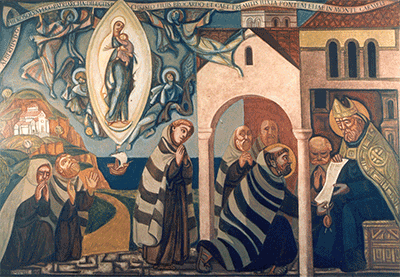
The Brown Scapular
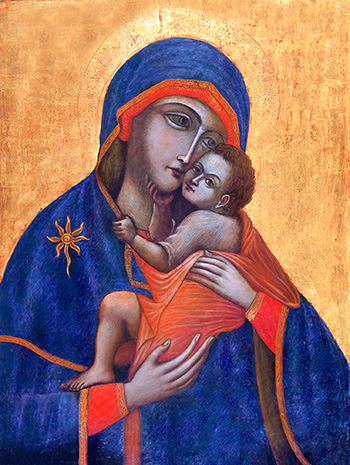 Signs in ordinary human life
Signs in ordinary human life
The world in which we live is full of material things which have symbolic meaning: light, fire, water...
There are also, in everyday life, experiences of relationships between human beings, which express and symbolise deeper realities such as sharing a meal (as a sign of friendship), taking part in a protest march (as a sign of solidarity), joining together in a national celebration (as a sign of identity).
We need signs and symbols to help us understand what is happening at present, or what happened before, and to give us an awareness of who we are, as individuals and as groups.
Signs in Christian life
Jesus is the great sign and gift of the Father’s love. He founded the Church as a sign and instrument of his love. Christian life also has its signs. Jesus used bread, wine, and water, to help us understand higher things, which we can neither see nor touch.
In the celebration of the Eucharist and the other sacraments (Baptism, Confirmation, Reconciliation, Matrimony, Holy Orders, the Sacrament of the Sick) the symbols, (water, oil, the laying on of hands, the rings), all have their own meaning and bring us into communication with God, present in each of them.
As well as liturgical signs, the Church has others related to some event, to some tradition, or some person. One of these is the Brown Scapular of Our Lady of Mount Carmel.
The Scapular is a sign of Mary
One of the signs in the tradition of the Church from many centuries ago is the Brown Scapular of Our Lady of Mount Carmel. It is a sign approved by the Church and accepted by the Carmelite Order as an external sign of love for Mary, of the trust her children have in her, and of commitment to live like her.
The word scapular indicates a form of clothing which monks wore when they were working.
With the passage of time, people began to give symbolic meaning to it: the cross to be borne every day as disciples and followers of Christ. In some religious orders, such as the Carmelites, the Scapular turned into a sign of their way of life. The Scapular came to symbolise the special dedication of Carmelites to Mary, the Mother of God, and to express trust in her motherly protection as well as desire to be like her in her commitment to Christ and to others. Thus it became a sign of Mary.
From Religious Orders to the People of God
In the middle ages many Christians wanted to be associated with the Orders founded at that time: Franciscans, Dominicans, Augustinians and Carmelites. Groups of lay people began to emerge in associations such as confraternities and sodalities.
All the religious Orders wanted to give these lay people a sign of affiliation and of participation in their spirit and apostolate. That sign was often a part of their habit: a cloak, a cord, a scapular.
Among the Carmelites, the stage came when a smaller version of the Scapular was accepted as the sign of belonging to the Order and an expression of its spirituality.
The value and meaning of the Scapular
The Scapular finds its roots in the tradition of the Order, which has seen in it a sign of Mary’s motherly protection. It has, therefore, a centuries old spiritual meaning approved by the Church:
It stands for a commitment to follow Jesus, as did Mary, the perfect model of all the disciples of Christ. This commitment finds its origin in baptism by which we become children of God.
The Blessed Virgin teaches us,
- to be open to God, and to his will shown to us in the people, circumstances and events of our lives;
- to listen to the Word of God in the bible and in life, to believe in it and to put into practice its demands;
- to pray always,as a way of discovering the presence of God in all that is happening around us;
- to be involved with people, being attentive to their needs.
It leads us into the community of Carmel, a community of religious and lay men and women, which has existed in the Church for eight centuries. It calls on us to live out the ideal of the Carmelite family: intimate friendship with God in prayer.
It reminds us of the example of the saints of Carmel, with whom we establish a close bond as brothers and sisters to one another.
It is an expression of our belief that we will meet God in eternal life, aided by the intercession and prayer of Mary.
Some practical rules
People are enrolled in the Scapular only once, by a priest or authorised person.
The Scapular can be replaced afterwards by a medal which has on one side the image of the Sacred Heart of Jesus and on the other the image of Mary.
The Scapular holds us to live as authentic Christians in line with the teaching of the Gospel, to receive the sacraments, to profess our special friendship for Mary, which should be expressed each day – for example, by praying the Hail Mary, prayerful reading of the Scriptures, service to someone in need.
The Carmelite Scapular
is not:
- a magical charm to protect you
- an automatic guarantee of salvation
- an excuse for not living up to the demands of Christian life;
it is:
A Sign which
stands for the decision to follow Jesus as Mary did:
- open to God and to God's will,
- guided by faith, hope and love,
- close to the needs of people,
- praying always,
- discovering God present in our life;
brings people into the family of Carmel;
with Mary's help, strengthens our desire to be with God forever.
Rite of Enrolment in the Brown Scapular
Finding Direction
Where are you going?
Do you know how to get there?
Here are four simple steps to help you find direction in your life:
- First, pray for direction, spend time in a quite place.
- Talk with others, consider your gifts, seek direction from your pastor or priest, a parent, or a spiritual guide.
- Listen to your feelings - do you know where you find discomfort, or what brings you discouragement? Where do you find satisfaction? What gives you energy for living? What brings you peace and joy?
- Above all, trust in who you are and know that God loves you and wants the best for you.
For me prayer is an aspiration of the heart,
it is a simple glance directed to heaven,
it is a cry of gratitude and love in the midst of trial
as well as joy.
Finally, it is something…. Which expands my soul
And unites me to Jesus.St Therese of Lisieux - Carmelite
For further information please contact Carmelite Vocations.
Discerning my personal Vocation
Discernment is experiencing with understanding and commitment
the presence and guidance of God in my whole life….
Ernest Larkin, O.Carm
You are looking into your future, and you are wondering where you should be, what you want to be, what God wants of you.
Because you have contacted the Carmelites, you may be thinking of religious life – and perhaps the priesthood too. But discovering what God wants – discernment – is exactly that: what God wants, whatever God wants. He may want you to be a Carmelite, but he may also want you to be married , or a single person with a career.
Starting a process of discernment demands a willingness to be open to whatever God wants: so it means not deciding before you start! Leave your heart open to God: whatever the decision you and God come to, God will give you the strength and the courage to follow it through.
The process of discernment consists of four steps. But they are not necessarily sequential; they are interconnected and overlapping and they are on-going. Now that you are trying to find what God wants of you, and throughout your life, you and God will continue on this journey of discovery.
Step One: Getting to Know Me
Knowing myself is much more that knowing what I think. It is being in touch with my thinking, and with my feeling and behaviour. It means being in touch with my life, my experience.
So it is more contemplative than analytic, more receptive than introspective. It is looking honestly at me: what I think about things, what I hold strongly; how I feel, about me and about others; how I act, and what motivates my activities.
Step Two: Getting to Accept Myself
If I apply myself to it, knowing myself maybe a comparatively easy exercise. Where the crunch comes is in looking at what I see and accepting it, all of it.
Accepting myself means owning my whole self – the good and the bad and the ugly. It means loving myself, not in a self-centred and exclusive way, but in the sense of accepting myself as God’s gift. St Paul put it well when he said ‘ we are God’s work of art’.
It means loving the whole me, accepting my reality. And it means beginning to trust myself, basing that trust on the fact that God trusts and loves me, and having a great sense of wonder and gratitude for that.
Step Three: Being Whole and Loved and Loving
As I begin to accept myself as a whole, I can begin to allow myself to be accepted and loved, perhaps especially by God. The first two steps haven’t been walked alone – God has been there, and I have been in touch with God through prayer, asking God’s help.
Now I am beginning to be integrated, beginning to accept my whole self. I am beginning to be open to God, open to what God is asking of me. I am beginning to see what God is asking of me.
I can do all this because I am real before God. I am accepting the real me – that good and bad and ugly – and beginning to love it, and because of this I can be honest with God and open to what God wants. I realise that God does not call the perfect to whatever God wants, but the real – the real me.
I may be encouraged in this realisation if I remember those first friends of Jesus – not perfect, but real.
And so I can be open to God. Herbert Alphonso SJ says:
We are called not to struggle towards God,
but to be receptive to God’s action in us.
Step Four: Checking it Out
Although your discernment is a personal process, it is carried out in context of a living community. Ernest Larkin says that the living community is the place of all discernment.
My living community is my family, friends, my total environment; it is Scripture, the people of God people in the church, people who journey with me through this process – a spiritual director or someone else with whom I have shared my searching.
My living community checks out my decision, and confirms it. And I continue to keep in touch with God, telling God of my decision and asking God to be with me as I seek to be what God wants.
A Gospel text that might help you
Although there are many biblical quotes that can help when you are trying to discover what God wants, perhaps one of the most helpful is from the first chapter of John’s gospel (John 1:35-39):
The next day John again was standing with two of his disciples,
and as he watched Jesus walk by, he exclaimed, "Look, here is the Lamb of God!"
The two disciples heard him say this, and they followed Jesus.
When Jesus turned and saw them following, he said to them, "What are you looking for?"
They said to him, "Rabbi" (which translated means Teacher), "where are you staying?"
He said to them, "Come and see." They came and saw where he was staying,
and they remained with him that day. It was about four o'clock in the afternoon.
One of the two who heard John speak and followed him was Andrew, Simon Peter's brother.
For further information please contact Carmelite Vocations.



















